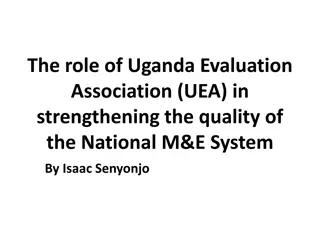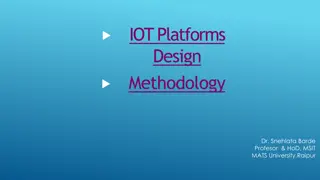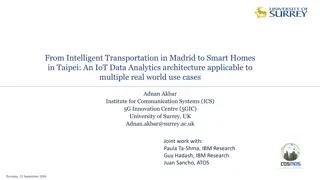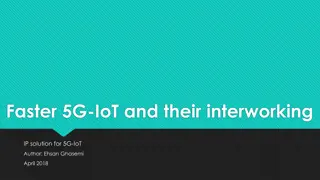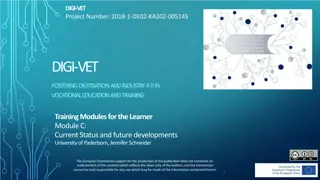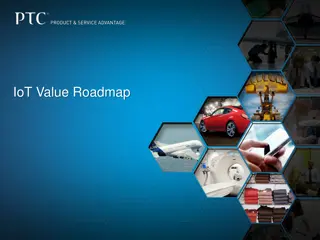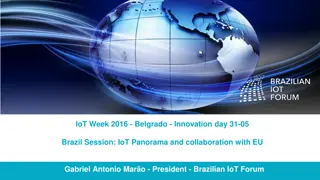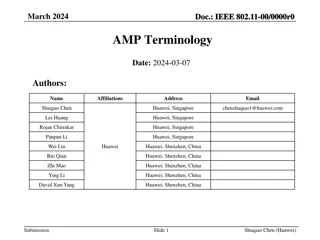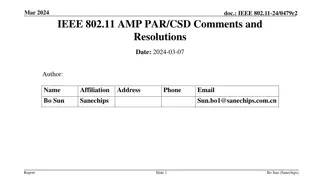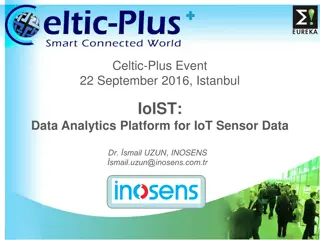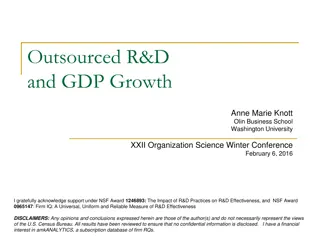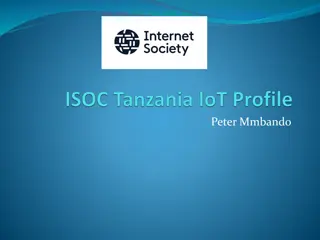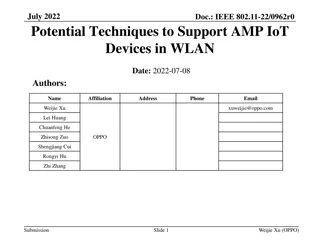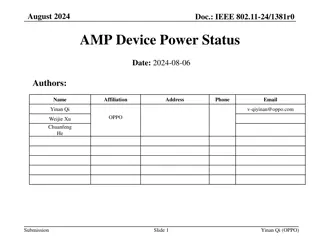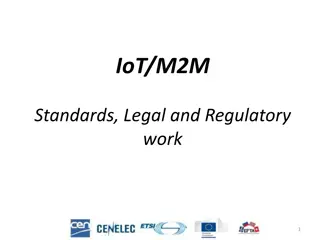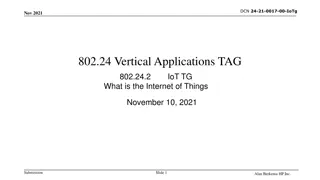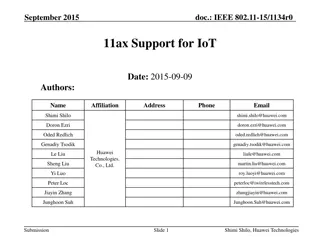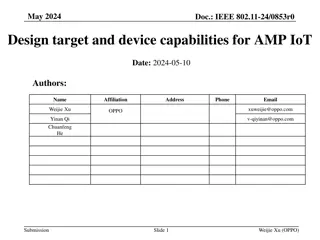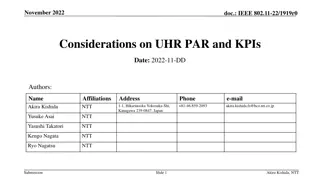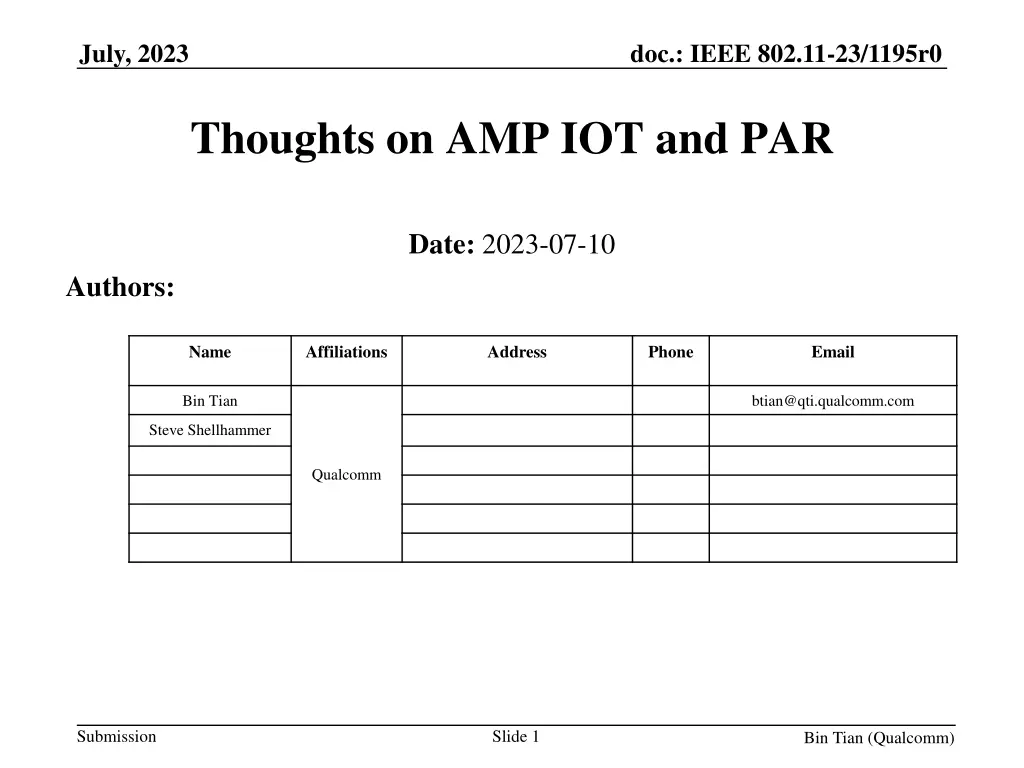
Wireless Communication Innovations for AMP IoT Devices
Explore the latest developments in IEEE 802.11-23/1195r0 for AMP IoT devices, focusing on new air interfaces, energy-efficient solutions, and standardized protocols for connecting with existing WLAN networks. Discover high-level topologies and the need for standardization in energizer links and AMP control signaling.
Download Presentation

Please find below an Image/Link to download the presentation.
The content on the website is provided AS IS for your information and personal use only. It may not be sold, licensed, or shared on other websites without obtaining consent from the author. If you encounter any issues during the download, it is possible that the publisher has removed the file from their server.
You are allowed to download the files provided on this website for personal or commercial use, subject to the condition that they are used lawfully. All files are the property of their respective owners.
The content on the website is provided AS IS for your information and personal use only. It may not be sold, licensed, or shared on other websites without obtaining consent from the author.
E N D
Presentation Transcript
July, 2023 doc.: IEEE 802.11-23/1195r0 Thoughts on AMP IOT and PAR Date: 2023-07-10 Authors: Name Affiliations Address Phone Email Bin Tian btian@qti.qualcomm.com Steve Shellhammer Qualcomm Submission Slide 1 Bin Tian (Qualcomm)
July, 2023 doc.: IEEE 802.11-23/1195r0 Introduction The discussions in AMP TIG and SG so far have been focused on adding new air interface for AMP IOT device There is also a market demand for WLAN AMP client devices that can connect with existing WLAN network AP s and infrastructure AMP client device Support existing WLAN standards (e.g. 2.4 GHz 11b/n) with optimized Tx/Rx power consumption Energizer RF Power harvester (Sub-1GHz) Operates in low duty cycle and supports additional AMP signaling/control (e.g. wake up signal ) to minimize power consumption AMP Energizer device Transmitter for Energizer signal in S1G band Ability to transmit AMP wake up signal / control signals to AMP Client device (S1G or 2.4GHz) Optional: serve as relay for 2.4 GHz (e.g. 11b/n) data comms between AMP Client and Infra AP & Cloud Submission Slide 2 Bin Tian (Qualcomm)
July, 2023 doc.: IEEE 802.11-23/1195r0 High Level Topology (model 1) AMP Client AMP Energizer Device AMP Client AFC Agent Other variations are also possible E.g. AP may send the wake-up signal directly. Energizer may have a link to AP to coordinate the schedule/control of wake-up signal Slide 3 Submission Bin Tian (Qualcomm)
July, 2023 doc.: IEEE 802.11-23/1195r0 High Level Topology with AMP Energizer Wi-Fi Relay (model 2) AMP Energizer & Relay Device AFC Agent AMP Client Other variations are also possible AMP client and AMP energizer may also use new air interface for communication Submission Slide 4 Bin Tian (Qualcomm)
July, 2023 doc.: IEEE 802.11-23/1195r0 What need to be standardized Energizer link Band (sub-1GHz, 2.4GHz?), channelization/BW, waveform(?) Its control/configuration may be done through AMP or Wi-Fi control/signaling AMP wake up link E.g. waveform, signaling, procedure, configurations, etc. AMP control signaling/protocol Configuration and control, procedure, etc. Optional relay operation Submission Slide 5 Bin Tian (Qualcomm)
July, 2023 doc.: IEEE 802.11-23/1195r0 High Level Inputs to PAR Need to support both sub1GHz and 2.4 GHz Define at least one mode of energizer link using wireless power transfer Define AMP link for wake up and control signaling Add support signaling to enable AMP device connecting to existing .11 network (e.g. 11b/n) Submission Slide 6 Bin Tian (Qualcomm)
July, 2023 doc.: IEEE 802.11-23/1195r0 Suggested PAR This amendment defines modifications to both the IEEE 802.11 Medium Access Control layer (MAC) and Physical Layers (PHY) to enable operation of ambient powered device by defining - at least one mode of wake up and data communication link in sub-1GHz or 2.4GHz - at least one mode for AMP IOT device to connect with legacy WLAN network in 2.4GHz band - at least one mode of wireless power transfer in sub-1GHz or 2.4GHz - at least one mode to support positioning function This amendment shall provide coexistence and backward compatibility with deployed devices compliant with IEEE Std 802.11 -2020 and operating in the same band. Submission Slide 7 Bin Tian (Qualcomm)

